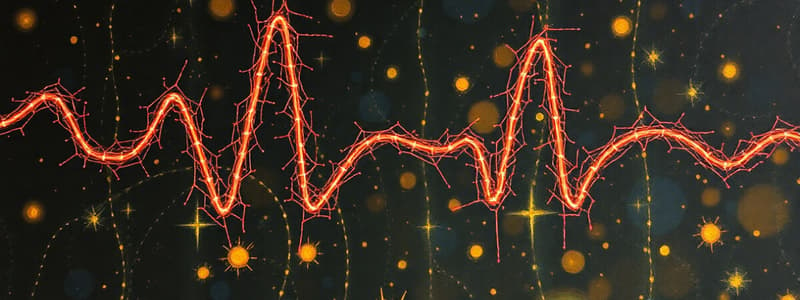Podcast
Questions and Answers
What is the resting membrane potential (RMP) mainly due to?
What is the resting membrane potential (RMP) mainly due to?
- More negative charge inside the cell compared to outside (correct)
- High concentration of potassium ions inside the cell
- Ion channels being fully open
- High concentration of sodium ions inside the cell
An absolute refractory period allows a second action potential to be initiated regardless of stimulation.
An absolute refractory period allows a second action potential to be initiated regardless of stimulation.
False (B)
What type of stimulation is necessary to evoke an action potential during the relative refractory period?
What type of stimulation is necessary to evoke an action potential during the relative refractory period?
Suprathreshold stimulation
In unmyelinated fibers, conduction is generally ______.
In unmyelinated fibers, conduction is generally ______.
Match the type of nerve fibers with their characteristics:
Match the type of nerve fibers with their characteristics:
Which of the following defines a motor unit?
Which of the following defines a motor unit?
Larger motor units have a low ratio, such as 1:5, and are generally responsible for force production.
Larger motor units have a low ratio, such as 1:5, and are generally responsible for force production.
What effect can extreme or prolonged ice, pressure, or anoxia have on nerve conduction speed?
What effect can extreme or prolonged ice, pressure, or anoxia have on nerve conduction speed?
The anatomical place where the nerve enters the muscle is known as the ______.
The anatomical place where the nerve enters the muscle is known as the ______.
Which type of muscle fibers typically requires smaller motor units for recruitment during voluntary contractions?
Which type of muscle fibers typically requires smaller motor units for recruitment during voluntary contractions?
Study Notes
Resting Membrane Potential (RMP)
- The inside of a cell is more negative than the outside at rest.
- A stimulus can cause a change in ion concentration, making the inside more positive (depolarization).
- This only happens if the RMP is below threshold.
Action Potential (AP)
- An impulse (AP) propagates along a nerve fiber until it synapses with another nerve or a muscle's motor end plate.
- APs are all-or-none, meaning they either happen fully or not at all, depending on whether the stimulus reaches threshold.
Refractory Periods
- Absolute Refractory Period: No stimulus can evoke an AP during this time.
- Relative Refractory Period: A suprathreshold stimulus is needed to evoke an AP during this time.
Stimulus Requirements
- The stimulus needs to have sufficient amplitude, duration, and rise time to reach threshold and overcome the membrane's accommodation.
Conduction Speed
- Myelinated fibers (large): Faster conduction; sensory and motor nerves.
- Unmyelinated fibers (small): Slower conduction; C fibers for pain.
- Conduction can slow down with extreme or prolonged ice, pressure, or lack of oxygen (anoxia).
Conductors and Insulators
- Conductors (high conductance): Nerve, muscle, motor points, trigger points.
- Insulators (low conductance): Adipose tissue, scar tissue.
Motor Point
- The anatomical location where a nerve enters a muscle.
- Charts exist to help with electrode placement for neuromuscular electrical stimulation (NMES).
Motor Unit
- A motor nerve and all the muscle fibers it innervates.
- Small motor units (low ratio, e.g., 1:5): Fine motor control (eyes, etc.).
- Large motor units (high ratio, e.g., 1:100 or more): Force production (quadriceps, anti-gravity muscles).
Voluntary vs. Electrical Stimulation Contractions
- Voluntary contractions: Smaller motor units are recruited before larger ones, resulting in a gradual contraction.
- Electrical stimulation: Larger motor units are recruited first, leading to a rapid, forceful contraction.
Studying That Suits You
Use AI to generate personalized quizzes and flashcards to suit your learning preferences.
Description
Explore the concepts of Resting Membrane Potential, Action Potentials, and Refractory Periods in this quiz. Learn how stimuli affect ion concentration and how nerve impulses propagate. Test your understanding of the mechanisms and requirements for neural signaling.





